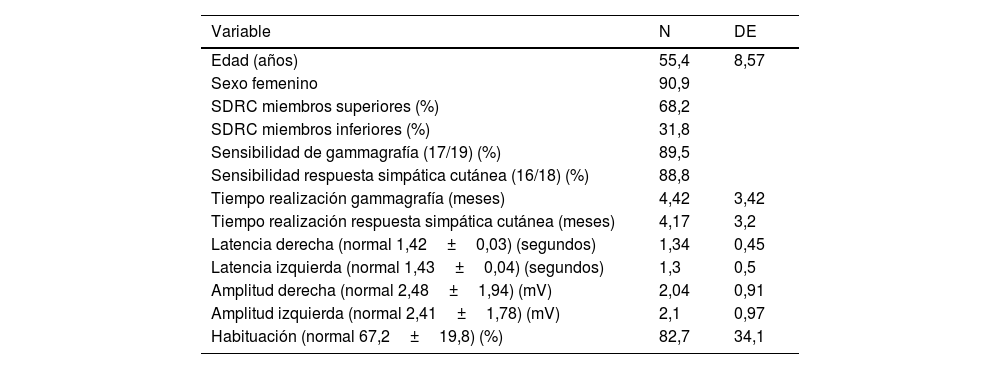Evaluar la sensibilidad de la respuesta simpática cutánea (RSC) y compararla con la gammagrafía en pacientes con síndrome de dolor regional complejo diagnosticados según criterios de Budapest.
Material y métodosSe evaluó prospectivamente a 22 pacientes con síndrome de dolor regional complejo que acudieron al Servicio de Rehabilitación y Medicina Física entre enero-2018 y mayo-2022. La gammagrafía se consideró positiva si en la 1.a-2.a fase se apreció leve captación asimétrica y difusa, o cuando en la 3.a fase se apreció marcada captación periarticular del radioisótopo. La RSC era anormal si se observaba: a) ausencia de respuesta tras 20 estímulos; b) falta de habituación con permanencia de los estímulos mayor al 67,2%.
ResultadosEdad 55,4±8,57 años. Síndrome de dolor regional complejo más frecuente en mujeres (90,9%), más común en miembros superiores (68,2%) que en inferiores (31,8%). En la RSC hemos observado respuesta normal (<67,2%) en 2 pacientes (11,1%), falta de RSC en 2 pacientes (11,1%) y falta de habituación (>67,2%) en 14 pacientes (77,8%). En total, 16 pacientes presentaron respuestas anormales o ausentes (88,8%). La sensibilidad diagnóstica de la gammagrafía es similar a la de la RSC (89,5 vs. 88,8%), sin diferencia estadística (p=0,6721).
ConclusiónLa Gammagrafía ha demostrado una sensibilidad similar a la RSC, aunque la simpleza, el bajo coste y la no invasividad de esta última técnica sugieren que podría ser más coste/efectiva y segura (no ionizante). La falta de habituación y la ausencia de respuesta podrían identificar patrones de respuesta y localizar la afectación en las vías aferente, central, eferente o post ganglionar.
To evaluate the sensitivity of sympathetic skin response (SSR) and compare it with scintigraphy in patients with complex regional pain syndrome diagnosed according to the Budapest criteria.
Material and methodsTwenty-two patients with complex regional pain syndrome who attended the Rehabilitation and Physical Medicine Department between January-2018 and May-2022 have been prospectively evaluated. The scintigraphy was considered positive if in the 1st-2nd phase slight asymmetric and diffuse uptake was observed, or when in the 3rd phase marked periarticular radioisotope uptake was observed. SSR was abnormal if: a) no response after 20 stimuli; b) lack of habituation with permanence of the stimuli greater than 67.2%.
ResultsAge 55.4±8.57 years. Complex regional pain syndrome was more frequent in women (90.9%), more common in upper limbs (68.2%) than lower limbs (31.8%). In SSR, we have observed normal response (<67.2%) in 2 patients (11.1%), lack of SSR in 2 patients (11.1%) and lack of habituation (>67.2%) in 14 patients (77.8%). In total, 16 patients presented abnormal or absent responses (88.8%). The diagnostic sensitivity of scintigraphy is similar to that of SSR (89.5% vs 88.8%), with no statistical difference (P=.6721).
ConclusionScintigraphy has shown similar sensitivity to SSR, although the simplicity, security, low cost, non-ionizing and non-invasiveness of the latter technique suggest that it could be more cost-effective. The lack of habituation and the absence of response could identify response patterns and localize the involvement in the afferent, central, efferent or post-ganglionic pathways.











